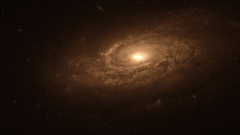NGC 3994
| NGC 3994 | |
|---|---|
 NGC 3994 by Hubble Space Telescope | |
| Observation data (J2000 epoch) | |
| Constellation | Ursa Major |
| Right ascension | 11h 57m 36.9s[1] |
| Declination | +32° 16′ 40″[1] |
| Redshift | 0.010279 ± 0.000009 [1] |
| Heliocentric radial velocity | 3,082 ± 3 km/s[1] |
| Distance | 161 ± 11.4 Mly (49.4 ± 3.5 Mpc)[1] |
| Apparent magnitude (V) | 12.7[2] |
| Characteristics | |
| Type | SA(r)c pec [1] |
| Apparent size (V) | 1.30′ × 0.64′[1] |
| Notable features | Interacting galaxy |
| Other designations | |
| UGC 6936, Arp 313, VV 249b, MCG +06-26-059, PGC 37616, HOLM 309B | |
NGC 3994 is an unbarred spiral galaxy in the constellation Ursa Major. The galaxy lies about 160 million light years away from Earth, which means, given its apparent dimensions, that NGC 3994 is approximately 70,000 light years across.[1] It was discovered by Heinrich d'Arrest on April 6, 1864.[3]
NGC 3994 forms a triplet of galaxies with NGC 3995, which lies 1.9 arcminutes, and NGC 3991, which lies 3.7 arcminutes away. The triplet has been included in Halton Arp's Atlas of Peculiar Galaxies as Arp 313. Both NGC 3995 and NGC 3991 have a disturbed appearance while NGC 3994 does not.[4] The triplet is part of the NGC 3966 Group or LGG 259. Other members include NGC 3966, NGC 3935, NGC 3986, IC 2973, UGC 6892, IC 2978, and IC 2979.[5][6]
The nucleus of the galaxy has been found to be active, and based on its spectral lines it is a composite object with LINER and HII region characteristics.[7] The nucleus lacks central ultraviolet emission when observed by the Hubble Space Telescope. Star formation knots are visible along the spiral arms, most of them with ages less than 20 million years, with no correlation between location and age.[8] The star formation rate of NGC 3995 is estimated to be 2.9±0.6 M☉ per year, with higher rates observed near the centre of the galaxy.[9]
References
[edit]- ^ a b c d e f g h "NASA/IPAC Extragalactic Database". Results for NGC 3994. Retrieved 2024-03-26.
- ^ "Revised NGC Data for NGC 3994". spider.seds.org. Retrieved 30 March 2024.
- ^ Seligman, Courtney. "NGC 3994". Celestial Atlas. Retrieved 19 November 2018.
- ^ Sandage, A., Bedke, J. (1994), The Carnegie Atlas of Galaxies. Volume I, Carnegie Institution of Washington
- ^ Garcia, A. M. (1 July 1993). "General study of group membership. II. Determination of nearby groups". Astronomy and Astrophysics Supplement Series. 100: 47–90. Bibcode:1993A&AS..100...47G. ISSN 0365-0138.
- ^ Makarov, Dmitry; Karachentsev, Igor (21 April 2011). "Galaxy groups and clouds in the local (z~ 0.01) Universe". Monthly Notices of the Royal Astronomical Society. 412 (4): 2498–2520. arXiv:1011.6277. Bibcode:2011MNRAS.412.2498M. doi:10.1111/j.1365-2966.2010.18071.x. S2CID 119194025.
- ^ Gonçalves, A. C.; Véron-Cetty, M.-P.; Véron, P. (March 1999). "AGNs with composite spectra: II. Additional data". Astronomy and Astrophysics Supplement Series. 135 (3): 437–466. arXiv:astro-ph/9811342. Bibcode:1999A&AS..135..437G. doi:10.1051/aas:1999183.
- ^ Eggers, D.; Weistrop, D.; Stone, A.; Nelson, C. H.; Hancock, M. (January 2005). "Hubble Space Telescope Observations of Star-forming Regions in NGC 3994/3995". The Astronomical Journal. 129 (1): 136–147. Bibcode:2005AJ....129..136E. doi:10.1086/426358.
- ^ Logroño-García, R.; Vilella-Rojo, G.; López-Sanjuan, C.; Varela, J.; Viironen, K.; Muniesa, D. J.; Cenarro, A. J.; Cristóbal-Hornillos, D.; Ederoclite, A.; Marín-Franch, A.; Moles, M.; Vázquez Ramió, H.; Bonoli, S.; Díaz-García, L. A.; Orsi, A.; San Roman, I.; Akras, S.; Chies-Santos, A. L.; Coelho, P. R. T.; Daflon, S.; Costa-Duarte, M. V.; Dupke, R.; Galbany, L.; González Delgado, R. M.; Hernandez-Jimenez, J. A.; Lopes de Oliveira, R.; Mendes de Oliveira, C.; Oteo, I.; Gonçalves, D. R.; Sánchez-Portal, M.; Schmidtobreick, L.; Sodré, L. (February 2019). "J-PLUS: Measuring H α emission line fluxes in the nearby universe". Astronomy & Astrophysics. 622: A180. arXiv:1804.04039. Bibcode:2019A&A...622A.180L. doi:10.1051/0004-6361/201732487.
External links
[edit]- NGC 3994 on WikiSky: DSS2, SDSS, GALEX, IRAS, Hydrogen α, X-Ray, Astrophoto, Sky Map, Articles and images
